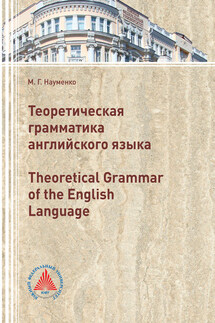Теоретическая грамматика английского языка (Theoretical Grammar of the English language) - страница 9
1. Nominative case (subject to a verb): rain falls.
2. Vocative (address): Are you coming, my darling?
3. Dative (indirect object to a verb): I gave John a penny.
4. Accusative (direct object and object to a preposition): The cat killed a rat. The ground is covered with snow.
This theory substitutes the functional characteristics of the part of the sentence for the morphological features of the word class (Blokh, 2000).
2. G. Curme presents the second viewpoint- the theory of prepositional cases. According to this theory combinations of nouns with prepositions should be viewed as morphological case forms. He distinguishes
a) the Dative case –to+N, for+N,
b) the Genitive case-of +N.
G. Curme considers these prepositions “inflexional prepositions”-equivalents to case forms. There are some objections to this theory. As any analytical language, English is characterized by extensive use of prepositions, many of which really require definite cases of nouns (prepositional case government). Prepositions render relations analogical to cases of nouns in declensional languages. But in this case all the other prepositional phrases in English must be regarded as “analytical cases”.
3. The third point of view was put forward by H. Sweet, O.Jespersen, Prof. A.I.Smirnitsky, and Prof. L.S.Barkhudarov. It is called “the limited case theory”. It was developed on the base of the oppositional approach. It differentiates two case forms: the possessive, or genitive form as the strong member of the opposition, and the common, or “non-genitive” form as the weak member.
4. There is another viewpoint of the problem of case differentiation in English, held by Russian linguists Prof.Vorontsova, Prof. Ilyish, Prof. Barkhudarov, Prof. Shteling and some others. It states that the English noun has completely lost its category of case in the course of its historical development. The relations thought as the ones rendered by the Genitive case are represented by a noun with a postposition which is similar to the noun with a preposition. This view is called “the theory of the possessive postposition”. To support this theory Prof. Vo-rontsova gives the example of possessive postposition “’s” attached not only to a single word, but to a phrase “ somebody else’s daughter”.
In Prof. Blokh’s opinion the phrasal use of the postpositional -’s has a stylistic colouring. Moreover, statistical data show that the –‘s is attached to individual nouns in 96% of its total use. Secondly, the –‘s has an obvious morphemic property; it is strictly postpositional, unlike the prepositions, and it’s not registered in dictionaries as a separate word.
To sum up, we share the viewpoint that there exists a two case declension of nouns in English. The sign- ‘s has a clear particle nature, it can be added both to individual nouns and nounal groups. Thus two types of Genitive can be differentiated: the word Genitive, and the phrase Genitive.
The category of article determination
The main formal element of the noun category of determination is the article (Blokh, 2000). The article is a determining unit of specific nature accompanying the noun. There are some other determiners in English, such as pronouns: this, any, some, which explicitly interpret the referent of the noun in relation to other objects or phenomena. The article just specifies the referent, defines it in the most general way. The use of the article is obligatory with nouns. There exist two basic approaches to the problem of the article status.


